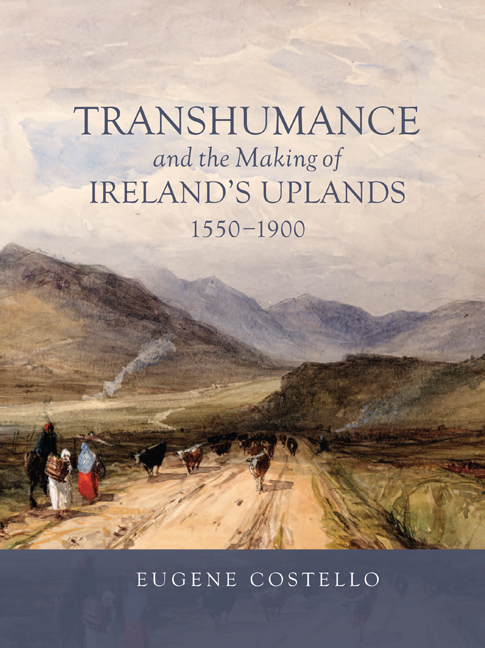Book contents
- Frontmatter
- Contents
- List of Illustrations
- Preface and Acknowledgements
- Note on Chronology
- Introduction
- Chapter 1 Seasonal Movement and Settlement in A World of Pastoralism
- Chapter 2 Imagining Movement: Past and Present Views of Transhumance in Ireland
- Chapter 3 Seasonal Sites in Context: Summer Pastures of the Carna Peninsula
- Chapter 4 Connected Places: Home and Booley in Gleann Cholm Cille Over Time
- Chapter 5 Altitude and Adaptation: Evolving Seasonal Settlement in the Galtee Mountains
- Chapter 6 Herders and Historical Forces, 1600–1900
- Conclusion
- Bibliography
- Index
- Frontmatter
- Contents
- List of Illustrations
- Preface and Acknowledgements
- Note on Chronology
- Introduction
- Chapter 1 Seasonal Movement and Settlement in A World of Pastoralism
- Chapter 2 Imagining Movement: Past and Present Views of Transhumance in Ireland
- Chapter 3 Seasonal Sites in Context: Summer Pastures of the Carna Peninsula
- Chapter 4 Connected Places: Home and Booley in Gleann Cholm Cille Over Time
- Chapter 5 Altitude and Adaptation: Evolving Seasonal Settlement in the Galtee Mountains
- Chapter 6 Herders and Historical Forces, 1600–1900
- Conclusion
- Bibliography
- Index
Summary
In spite of disparaging and vague remarks on Irish pastoralism by English commentators in the late sixteenth and early seventeenth centuries, there is now good reason to believe that, throughout the post-medieval period, transhumance was a stable, wellorganised form of cattle farming. It was not long-distance or unpredictable; rather, it took place over distances that rarely exceeded 12km (frequently less in the nineteenth century) and with reference to set units of land – such as between smaller internal units within a parish, from one parish to an adjoining area of commonage outside the parish, or from several parishes to one large shared commonage. That seasonal movements of livestock are always grounded in political, economic and environmental realities is implicit in the distribution of transhumant systems in the sixteenth and seventeenth centuries: even then, farmers in the most productive expanses of lowland do not seem to have practised transhumance at all, their landscape being too densely settled and rough pasture occurring in patches that were too small and disparate for seasonal settlement to be a necessity.
THE VISIBILITY OF TRANSHUMANCE IN UPLAND LANDSCAPES
Where seasonal pastoral movements were necessary they are most clearly attested in today's cultural landscape by the remains of small houses and huts that both published and unpublished oral history indicate were occupied in summertime by herders who tended to and milked dairy cows. Many of these structures were in use up to the nineteenth century, and later still on rough pastures in the Carna peninsula and Achill Island. While they had a number of regional names, this book has chosen to refer to individual summer dwellings as either ‘booley’ houses or ‘booley’ huts (depending on their size), which stems from the Irish-language word buaile, meaning a milking place in summer pasture, or simply summer pasture.
The archaeological remains of booley dwellings are generally found on unenclosed and unimproved rough pasture between an altitude of 50m and 550m a.s.l., depending on the regional topography – the Carna peninsula containing examples of the former and the Galtee Mountains having examples approaching the latter elevation. All of them are located within a few hundred metres of a water source.
- Type
- Chapter
- Information
- Transhumance and the Making of Ireland's Uplands, 1550–1900 , pp. 178 - 186Publisher: Boydell & BrewerPrint publication year: 2020



